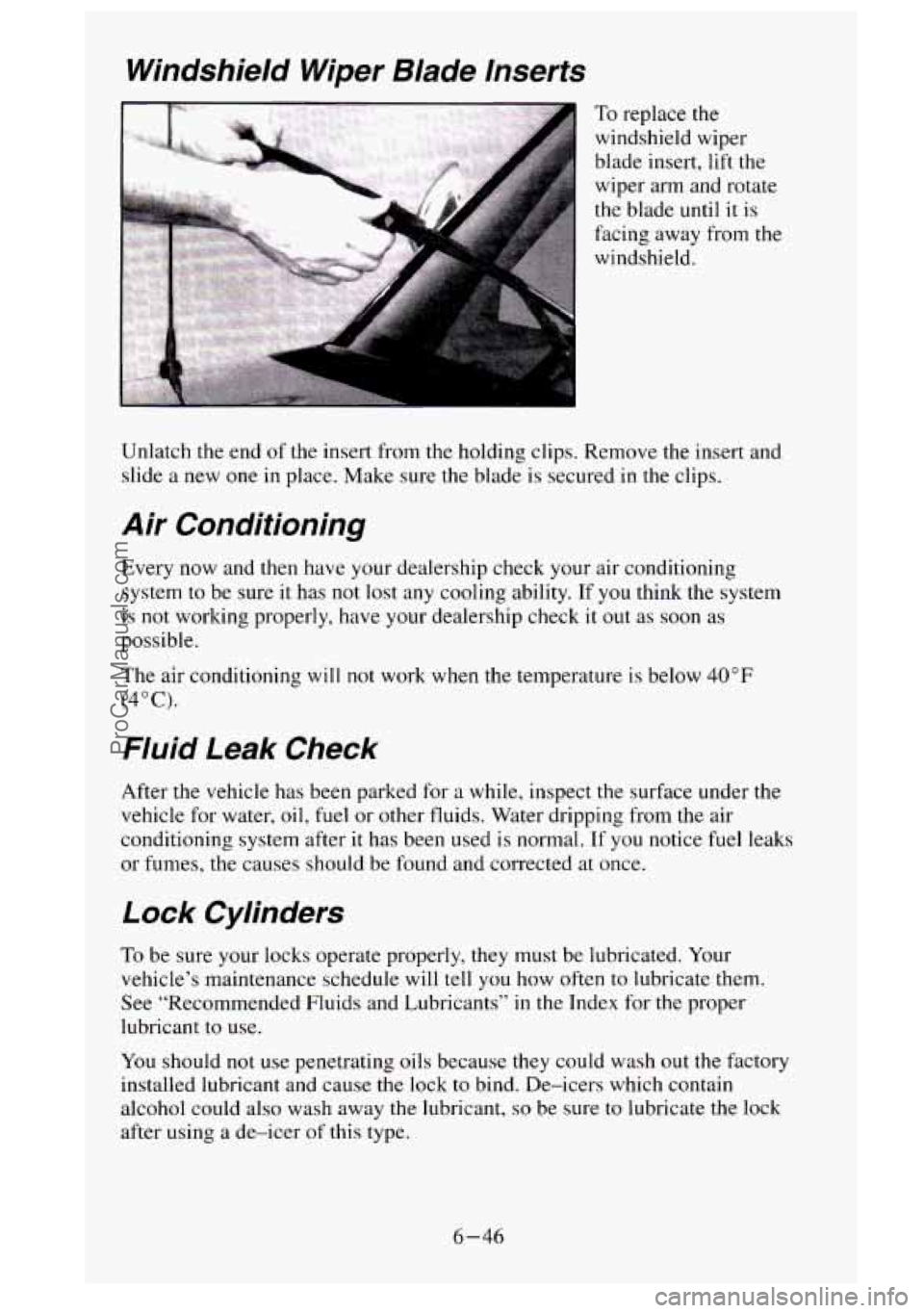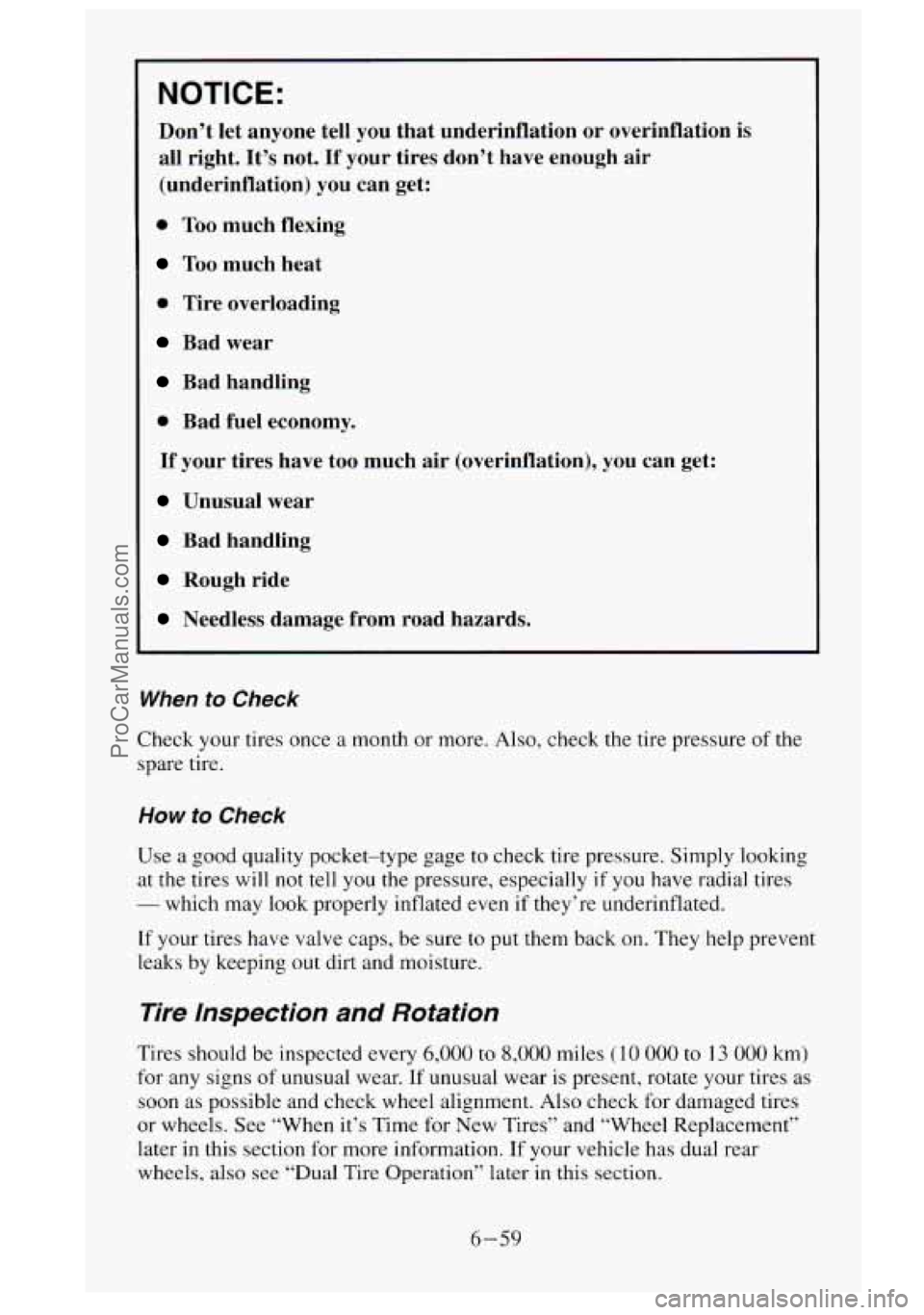Page 278 of 488
While refueling, hang
the cap inside the fuel
door.
To take off the cap, turn it slowly to the left (counterclockwise).
-~
A CAUTION:
If you get gasoline on yourself and then something ignites it, you
could be badly burned. Gasoline can spray out on you if you
1 open the fuel filler cap too quickly. This spray can happen if
your tank is nearly full, and
is more likely in hot weather. Open
the
fuel filler cap slowly and wait for any “hiss” noise to stop.
Then unscrew the cap all the way.
Be careful not to spill gasoline. Clean gasoline from painted surfaces as
soon as possible. See “Cleaning the Outside of Your Vehicle” in the Index.
When
you put the cap back on, turn it to the right until you hear a clicking
noise.
1 NOTICE:
If you need a new cap, be sure t.0 get the right type. Your dealer
can get one for you.
If you get the wrong type, it may not fit or
have proper venting, and your fuel tank and emissions system
might be damaged.
6- 12
ProCarManuals.com
Page 312 of 488

Windshield Wiper Blade Inserts
To replace the
windshield wiper
blade insert, lift
the
wiper arm and rotate
the blade until
it is
facing away from the
windshield.
Unlatch the end
of the insert from the holding clips. Remove the insert and
slide
a new one in place. Make sure the blade is secured in the clips.
Air Conditioning
Every now and then have your dealership check your air conditioning
system to be sure it
has not lost any cooling ability. If you think the system
is not working properly, have your dealership check it out as soon as
possi bleb
The air conditioning will
not work when the temperature is below 40°F
(4°C).
Fluid Leak Check
After the vehicle has been parked for a while, inspect the surface under the
vehicle for water, oil, fuel
or other fluids. Water dripping from the air
conditioning system after it has been used is normal.
If you notice fuel leaks
or fumes, the causes should be found and corrected at once.
Lock Cylinders
To be sure your locks operate properly, they must be lubricated. Your
vehicle’s maintenance schedule will tell you how often to lubricate them.
See “Recommended Fluids and Lubricants” in the Index for
the proper
lubricant to use.
You should
not use penetrating oils because they could wash out the factory
installed lubricant and cause
the lock to bind. De-icers which contain
alcohol could also
wash away the lubricant, so be sure to lubricate the lock
after using
a de-icer of this type.
6-46
ProCarManuals.com
Page 325 of 488

NOTICE:
Don’t let anyone tell you that underinflation or overinflation is
all right. It’s not.
If’ your tires don’t have enough air
(underinflation)
you can get:
0 Too much flexing
Too much heat
0 Tire overloading
Bad wear
Bad handling
0 Bad fuel economy.
If your tires have too much air (overinflation), you can get:
Unusual wear
Bad handling
Rough ride
Needless damage from road hazards.
When to Check
Check your tires once a month or more. Also, check the tire pressure of the
spare tire.
How to Check
Use a good quality pocket-type gage to check tire pressure. Simply looking
at the tires will not tell you the pressure, especially
if you have radial tires
- which may look properly inflated even if they’re underinflated.
If your tires have valve caps, be sure to put them back on. They help prevent
leaks by keeping out dirt and moisture.
Tire Inspection and Rotation
Tires should be inspected every 6,000 to 8,000 miles (10 000 to 13 000 km)
for any signs of unusual wear. If unusual wear is present, rotate your tires as
soon as possible and check wheel alignment. Also check for damaged tires
or wheels. See “When it’s Time for New Tires” and “Wheel Replacement”
later in this section for more information.
If your vehicle has dual rear
wheels, also see
“Dual Tire Operation” later in this section.
6-59
ProCarManuals.com
Page 347 of 488
Engine Identification - Gasoline Engines
Engine
Type
VIN Code
Fuel System
Emissions
5.0L
V8
H
TBI? LD
"Light Duty Emissions with
8,500 lbs. (3 850 Kg) GVWR and below.
**Heavy Duty Emissions over 8,500 lbs. (3 850 Kg) GVWR.
?Throttle Body Injection
Engine Identification - Gasoline Engines (cont.)
Engine
Type
VIN Code
Fuel System
Emissions 7.4L
V8
N
TBI?
LD*/HD**
"Light Duty Emissions with 8,500 lbs. (3 850 Kg) GVWR and below.
""Heavy Duty Emissions over
8,500 lbs. (3 850 Kg) GVWR.
?Throttle Body Injection
Engine Identification - Diesel Engines
Engine
Type
VIN Code
Fuel System
6.5L
V8
P
Diesel
6.5L
V8 S
Turbo Diesel
6.5L
V8
F
Turbo Diesel
6-81
ProCarManuals.com
Page 349 of 488
CranKcase Capacity
ENGINE
4.3L 5 .OL
5.7L“
6.5L
6.5L
6.5L
7.4L>$
VIN
Z
€4
K
P
S
F
N
QUANTITY WITH
FILTER*
4.5 Quarts (4.3 Liters)
5 Quarts (4.8 Liters)
5 Quarts (4.8 Liters)
7 Quarts (6.5 Liters)
7 Quarts
(6.5 Liters)
7 Quarts (6.5 Liters)
7 Quarts (6.5 Liters)
After refill, the level
MUST be checked as outlined under “Engine Oil And
Filter Recommendations”
in Section 5.
All quantities are approximate.
“Add one additional quart for
C3500 HD Models.
+Oil filter should be changed at EVERY oil change.
Fuel Tank Capacity
TYPE
Gasoline/Diesel
with Short Bed
with Long Bed
Crew Cab
Standard
Chassis-Cab Models
Standard (Side Tank)
Optional (Rear Tank)
3500 HD Models
Standard (Side Tank)
Optional (Rear Tank)
QUANTITY
26 Gallons (98 Liters)
34 Gallons
(1 28 Liters)
34 Gallons
(1 28 Liters)
23 Gallons (87 Liters)
3
1 Gallons (1 17 Liters)
23 Gallons (87 Liters)
3 1 Gallons ( 117 Liters)
All quantities are
for a completely dry tank and are approximate.
6-83
ProCarManuals.com
Page 350 of 488
Service Replacement Part and Filter
Recommendations
- Gasoline Engines
Engine 4.3L
VTN Z
Oil Filter PFS2
Air Cleaner
A 178CW
Filter
PCV Valve CV789C
Spark
Plugs* .CR43TS
Fuel Filter GF48
1
Radiator Cap
RC36
5.0L
H
PF12183-
A348C
cv774c
.CR43TS
GF48
1
RC36
5.7L
K
PF1218q A348C
cv774c
.CR43TS GF38
1
RC36
+Four Wheel Drive Vehicle
- use a PFS2 oil filter
Wse AC copper-cored resistor type spark plugs
Service Replacement Part and Filter
Recommendations
- Diesel Engines
Engine 6.5L 6.5L
VIN P S
Oil Filter PF1218
PF1218
Air Cleaner A644C
A 1236C
Fuel Filter TP
1006 TP
1 006
Surge
Tank Cap RC33 RC33
7.41
N
PF1218
A348C
cv774c
.CR43TS GF48
I
RC36
6.51
F
PF1218
A 1236C
TP
I006
RC33
6-84
ProCarManuals.com